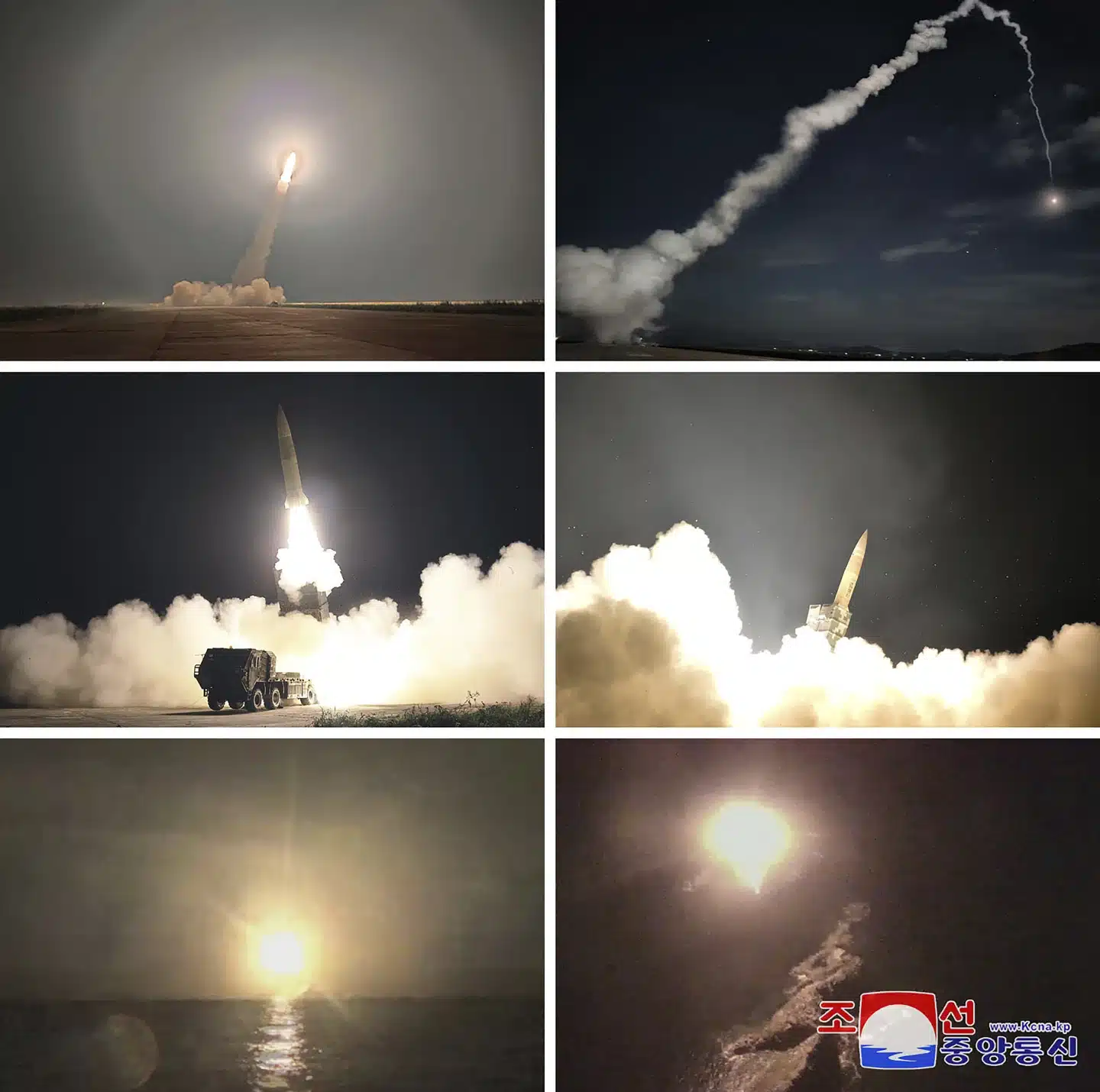News
North Korea Says It Simulated Nuclear Attacks On South Korea And Rehearsed Occupation Of Its Rival

South Korea’s SEOUL — North Korea said Thursday that its recent missile launches mimicked “scorched earth” nuclear strikes on South Korea and that it has also been practicing occupying its rival’s territory in the case of war.
Pyongyang has already tested nuclear-capable missiles and indicated how they would be used in hypothetical conflicts with South Korea and the United States. However, according to observers, the North’s disclosure of specific war plans underlined its aggressive nuclear strategy to terrify its opponents, as it escalated its protest of the continuing South Korean-US military drills, which it sees as a huge security threat.
According to the official Korean Central News Agency, North Korea’s military fired two tactical ballistic missiles from the capital on Wednesday night to practice “scorched earth strikes” on major command centers and operational airfields in South Korea.
The North Korean military claimed that the missiles carried out their simulated hits via air bursts, implying that it validated the explosions of dummy warheads at a predetermined altitude.
North Korea claimed its missile tests were in response to the US flying long-range B-1B bombers over South Korea earlier Wednesday as part of the partners’ field drills.
South Korea’s SEOUL — North Korea said Thursday that its recent missile launches mimicked “scorched earth” nuclear strikes on South Korea.
“(The aerial drill) poses a serious threat to (North Korea) because it was conducted in accordance with the scenario for a preemptive nuclear strike against” North Korea, according to the Korean People’s Army general staff. “The KPA will never forget the reckless actions of US forces and (South Korean) military gangsters.”
The Wednesday missile launches were the most recent in the North’s onslaught of weapons testing since last year.
According to estimates from South Korea and Japan, the two short-range missiles flew 360-400 kilometers (225-250 miles) at a maximum height of 50 kilometers (30 miles) before landing in the waters between the Korean Peninsula and Japan.
South Korea’s Joint Chiefs of Staff described the launches as “a grave provocation” that endangers international peace and breaches United Nations Security Council resolutions prohibiting North Korean ballistic missile launches. The US Indo-Pacific Command stated that the US commitment to South Korean and Japanese defense remained “ironclad.”
On Wednesday, South Korean and Japanese authorities reported their jets engaged in joint aerial exercises with US B-1B bombers. According to South Korea’s Defence Ministry, Wednesday’s B-1B deployment is the tenth flypast by US bombers over the Korean Peninsula this year.
North Korea is highly concerned with deploying US B-1B bombers capable of carrying many conventional bombs. The North describes the bombers as “nuclear strategic” even though they were converted to conventional weapons in the 1990s.
South Korea’s SEOUL — North Korea said Thursday that its recent missile launches mimicked “scorched earth” nuclear strikes on South Korea.
The United States and South Korea began their summer Ulchi Freedom Shield computer-simulated command post exercise on August 21. This year’s training, which is set to culminate later Thursday, has featured more than 30 field exercises, such as Wednesday’s combined aerial exercise with the B-1B aircraft.
North Korea describes significant US-led military exercises on and around the Korean Peninsula as preparation for an invasion. Officials in both Washington and Seoul argue that their exercises are defensive. The United States has approximately 28,000 troops stationed in South Korea.
According to KCNA, Kim visited an army base on Tuesday where his troops have been undertaking command post maneuvers in reaction to the South Korean-US military training. The drills are intended to practice procedures for “occupying the entire territory of the southern half” of the Korean Peninsula in the event of a conflict, according to the statement.
Kim emphasized the importance of “dealing a heavy blow at the enemy’s war potential and war command centre, as well as blinding their means of command communication at the initial stage of operation.” According to KNCA, Kim also specified requirements for acquiring the ability to launch “simultaneous super-intense strikes” at important enemy military objectives and other places whose destruction can bring social and economic upheaval.
According to researcher Cheong Seong-Chang of South Korea’s private Sejong Institute, the North’s study shows it has operational plans to launch full-fledged attacks on South Korea during armed hostilities between the rivals to achieve Korean unification by force. He claimed North Korea was planning nuclear and EMP (electromagnetic pulse) attacks early in the war.
South Korea’s SEOUL — North Korea said Thursday that its recent missile launches mimicked “scorched earth” nuclear strikes on South Korea.
Later Thursday, South Korea’s Unification Ministry harshly condemned North Korea for publicly declaring its intention to invade the South. It warned North Korea that if it maintains its provocations and military threats, it will face “an overwhelming response” from South Korea, the United States, and Japan.
According to the ministry, it was the first report on command post training involving the whole military since Kim took office in late 2011.
Since last year, when it passed new legislation authorizing nuclear weapons in various situations, North Korea has openly threatened to deploy its nuclear weapons first in prospective battles with South Korea and the United States.
Kim has been working hard to grow and modernize his arsenal of weaponry. Its second effort to launch a spy satellite failed last week, but a third attempt is planned for October.
Foreign experts believe Kim will eventually utilize his expanded military arsenals to push the US to make concessions when negotiation restarts.
SOURCE – (AP)
News
Britain Must Be Ready for War in 3 Years, Warns New Army Chief

The new head of the Army has stated that Britain must be prepared to fight a war within three years.
Gen Sir Roland Walker has issued a warning about a variety of risks in what he calls a “increasingly volatile” environment.
However, he stated that war was not inevitable and that the Army had “just enough time” to prepare to prevent conflict.
He stated that the Army’s fighting capacity would be doubled by 2027 and tripled by the end of the decade.
Gen Walker warned that the Britain was under threat from a “axis of upheaval” in his first speech as Prime Minister on Tuesday.
Among the primary concerns confronting the Britain in the next years, as noted by the general in a briefing, is an enraged Russia, which may seek vengeance on the West for helping Ukraine, regardless of who wins the war.
He stated: “It doesn’t matter how it finishes. I believe Russia will emerge from it weaker objectively – or completely – but still very, very dangerous and seeking some form of retaliation for what we have done to assist Ukraine.”
Britain’s Government Defence Review and Military Challenges
He also warned that China was determined to retake Taiwan, and Iran was likely to seek nuclear weapons.
He stated that the threats they posed may become particularly acute in the next three years, and that these countries had formed a “mutual transactional relationship” since the war in Ukraine, sharing weaponry and technology.
However, he stated that the path to conflict was not “inexorable” if the UK re-established credible land troops to assist its deterrent strategy for avoiding war.
In his speech, he described his force of slightly over 70,000 regular troops as a “medium-sized army” and made no direct call for additional resources or men.
However, he pushed the British Army to adapt swiftly, focussing on technology such as artificial intelligence and weaponry rather than numbers.
His ultimate goal is for the Army to be capable of destroying an opponent three times its size.
This would entail firing quicker and farther, he said, aided by lessons learnt from the Ukraine war.
The general’s speech at the Royal United Services Institute land warfare conference comes only one week after the government began a “root and branch” defence review to “take a fresh look” at the challenges facing the armed services.
Defence Secretary John Healey launched the assessment, describing the existing status of the armed forces as “hollowed-out” and stating that “procurement waste and neglected morale cannot continue”.
According to the most recent Ministry of Defence (MoD) numbers from April 2024, the Britain’s regular Army forces total 75,325 troops (excluding Gurkhas and volunteers).
That figure has been declining in recent years, as recruiting has failed to match retention. The previous Conservative administration lowered the planned headcount from 82,000 to 72,500 by 2025.
Members of the NATO military alliance have agreed to spend at least 2% of GDP on defence by 2024, but several countries are unlikely to fulfil this goal.
The Britain presently spends 2.3% of its GDP on defence. Prime Minister Sir Keir Starmer has previously stated that the defence review will include a “roadmap” for increasing this to 2.5%, however he has yet to provide a date for this promise.
Source: BBC
News
Katie Ledecky Hopes For Clean Races At Paris Olympics In The Aftermath Of The Chinese Doping Scandal

PARIS — Katie Ledecky is looking for clean Olympic races. On Wednesday, Hope had pretty much reached her limit.
The American swimmer hopes to add to her six gold medals as she competes in the 400, 800, and 1,500 meters at the Paris Games. Her program starts with the heavy 400 on Saturday, featuring Ariarne Titmus and Summer McIntosh.

Katie Ledecky | ESPN Image
Katie Ledecky Hopes For Clean Races At Paris Olympics In The Aftermath Of The Chinese Doping Scandal
The 27-year-old Katie is competing in her fourth Summer Olympics, but the first since a doping scandal involving almost two dozen Chinese swimmers who tested positive for a banned chemical before the Tokyo Games — yet were permitted to compete with no consequences. The controversy has raised serious worries regarding the effectiveness of anti-doping initiatives.

Katie Ledecky | Vogue Image
“I hope everyone here is going to be competing clean this week,” Ledecky claimed. “But what truly counts is, were they training cleanly? Hopefully this has been the case. Hopefully, there has been worldwide testing.”
The International Olympic Committee has expressed concern over the ongoing US investigation into possible doping by Chinese swimmers. While awarding the 2034 Winter Olympics to Salt Lake City on Wednesday, the IOC urged Utah officials to do whatever they could to stop the FBI investigation.
“I think everyone’s heard what the athletes think,” Katie added. “They seek transparency. They want more answers to the remaining questions. At this point, we are here to race. We are going to race whoever is in the lane next to us.
“We are not paid to conduct the tests, so we trust those who follow their regulations. That applies both today and in the future.

Katie Ledecky | ESPN Image
Katie Ledecky Hopes For Clean Races At Paris Olympics In The Aftermath Of The Chinese Doping Scandal
SOURCE | AP
News
London Heatwave Alert: High Temperatures Set to Soar to 29C Next Week

As the summer holidays begin, London may experience an official heatwave with temperatures reaching up to 29 degrees Celsius.
The Met Office predicts a long period of sunny and dry weather for London after a soggy spring and summer.
After a cloudy day on Saturday, temperatures are expected to reach 27C on Sunday, with lots of sunlight.
On Monday and Tuesday, temperatures are forecast to peak at 29 degrees Celsius. Monday is forecast to offer more sunlight, while Tuesday may see some gloomy weather.
Temperatures are expected to remain in the high 20s next week, with lows of approximately 18C.
According to the Met Office, a heatwave is “an extended period of hot weather relative to the expected conditions of the area at that time of year, which may be accompanied by high humidity.”
In the United Kingdom, a heatwave is proclaimed when daily temperatures meet or surpass a certain level for at least three consecutive days.
In London, the heatwave threshold is 28 degrees Celsius.
The Met Office reported that the UK is experiencing hotter and wetter weather on average due to climate change.
The UK experienced its warmest May and April on record this year, despite damp and dismal conditions in many areas.
According to the Met Office’s State Of The UK Climate 2023 report published on Thursday, the UK experienced historic levels of extreme weather last year.
In the United Kingdom, 2023 was the second warmest year on record, bringing storms, flooding, strong heatwaves, and rising sea levels; only 2022 was warmer.
It was 0.8°C higher than the average from 1991 to 2020, and 1.66°C higher than the 1961 to 1990 average.
However, 2023 will be a “cool year” in comparison to 2100, based on the planet’s warming trajectory.
The government’s plan to adapt to the hazards presented by climate change is currently being challenged in the High Court by campaigners who allege the Tory administration’s July 2023 National Adaptation Programme (NAP) fails to adequately address 61 concerns.
Source: The Standard
-
World2 weeks ago
Former President Trump Survives Being Shot at Pennsylvania Rally
-
Tech4 weeks ago
Huawei Launches 5G-A Pioneers Program at MWC Shanghai 2024: Paving the Way for a Connected Future
-
Sports4 weeks ago
NBA Draft: Kyle Filipowski Withdraws Unexpectedly From The First Round
-
Tech4 weeks ago
ChatGPT Answers Undiscovered Questions and Outperforms Students.
-
News4 weeks ago
US Supreme Court Rejects Drug Deal that Protects the Sackler Family
-
Health4 weeks ago
US Health Agency Issues Dengue Virus Infection Warning
























